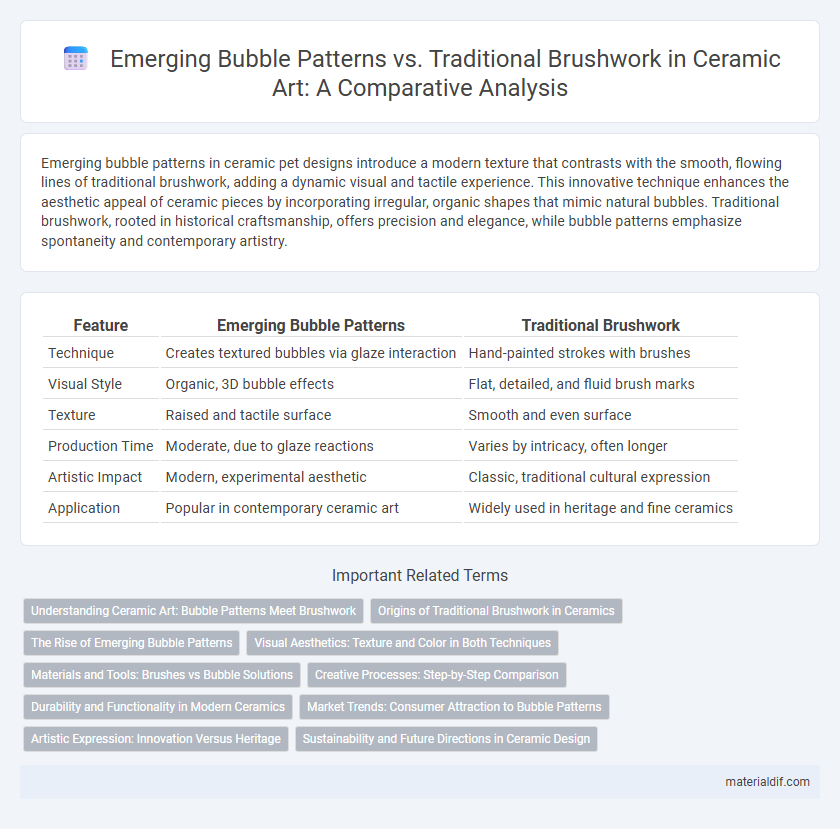Emerging bubble patterns in ceramic pet designs introduce a modern texture that contrasts with the smooth, flowing lines of traditional brushwork, adding a dynamic visual and tactile experience. This innovative technique enhances the aesthetic appeal of ceramic pieces by incorporating irregular, organic shapes that mimic natural bubbles. Traditional brushwork, rooted in historical craftsmanship, offers precision and elegance, while bubble patterns emphasize spontaneity and contemporary artistry.
Table of Comparison
| Feature | Emerging Bubble Patterns | Traditional Brushwork |
|---|---|---|
| Technique | Creates textured bubbles via glaze interaction | Hand-painted strokes with brushes |
| Visual Style | Organic, 3D bubble effects | Flat, detailed, and fluid brush marks |
| Texture | Raised and tactile surface | Smooth and even surface |
| Production Time | Moderate, due to glaze reactions | Varies by intricacy, often longer |
| Artistic Impact | Modern, experimental aesthetic | Classic, traditional cultural expression |
| Application | Popular in contemporary ceramic art | Widely used in heritage and fine ceramics |
Understanding Ceramic Art: Bubble Patterns Meet Brushwork
Emerging bubble patterns in ceramic art create unique textures by trapping air during the firing process, contrasting sharply with the deliberate strokes of traditional brushwork. These dynamic bubbles introduce organic, unpredictable elements that enhance the tactile quality of the ceramic surface. By blending bubble patterns with brushwork techniques, artists achieve a compelling interplay of spontaneity and precision, enriching the visual and sensory experience of ceramic pieces.
Origins of Traditional Brushwork in Ceramics
Traditional brushwork in ceramics traces its origins to ancient Chinese pottery, where artisans used fine brushes to create intricate designs symbolizing nature and spirituality. This technique emphasizes meticulous hand-painted details, often featuring floral motifs and calligraphic strokes that reflect cultural heritage. Unlike emerging bubble patterns, which prioritize texture and modern aesthetics, traditional brushwork relies on skilled brush manipulation to evoke historical artistry and craftsmanship.
The Rise of Emerging Bubble Patterns
Emerging bubble patterns in ceramics offer a visually dynamic alternative to traditional brushwork by creating textured, three-dimensional surfaces that capture light and shadow uniquely. These patterns are achieved through innovative glazing techniques that produce controlled bubble formations during firing, resulting in organic, unpredictable designs that enhance tactile appeal. The rise of bubble patterns reflects a growing trend among ceramic artists seeking to push boundaries beyond classic brush strokes, emphasizing experimental textures and modern aesthetics.
Visual Aesthetics: Texture and Color in Both Techniques
Emerging bubble patterns in ceramics create a distinctive visual texture characterized by irregular, organic shapes and subtle color variations achieved through controlled glazing and firing techniques. Traditional brushwork emphasizes precise, deliberate strokes that result in smoother surfaces with bold, contrasting colors and intricate designs. Both methods offer unique aesthetic appeals: bubble patterns enhance tactile depth and natural irregularity, while brushwork showcases refined detail and vibrant color saturation.
Materials and Tools: Brushes vs Bubble Solutions
Emerging bubble patterns in ceramics utilize specialized bubble solutions made from non-toxic detergents mixed with water and ceramic slip, enabling artists to create organic, unpredictable textures that contrast sharply with the controlled, precise strokes achieved using traditional brushes composed of natural or synthetic bristles. Brushes allow for detailed manipulation of glaze and surface design through variation in pressure and angle, while bubble solutions rely on the physical interaction between bubbles and clay surfaces to form unique, layered effects. This innovative approach expands the material toolkit in ceramic art by integrating fluid dynamics with conventional slip application, offering new tactile and visual dimensions that traditional brushwork cannot replicate.
Creative Processes: Step-by-Step Comparison
Emerging bubble patterns in ceramics involve layering slip or glaze and capturing air bubbles to create unique textures, contrasting with traditional brushwork that relies on hand-painted strokes and controlled designs. The bubble technique requires careful timing to trap bubbles before firing, resulting in organic, unpredictable patterns, whereas brushwork demands precision and steady hand coordination for detailed imagery. Both processes showcase distinct artistic approaches, with bubble patterns emphasizing spontaneity and texture, while brushwork highlights deliberate craftsmanship and form.
Durability and Functionality in Modern Ceramics
Emerging bubble patterns in modern ceramics exhibit enhanced durability due to their unique surface texture, which disperses stress and reduces crack propagation compared to traditional brushwork techniques. These patterns contribute to improved functionality by increasing grip and minimizing wear, making them ideal for contemporary utilitarian pottery. Traditional brushwork offers aesthetic appeal but often lacks the structural resilience found in bubble-patterned ceramics, impacting long-term usability.
Market Trends: Consumer Attraction to Bubble Patterns
Emerging bubble patterns in ceramic design capture growing consumer interest through their unique texture and visual appeal, creating a fresh alternative to traditional brushwork techniques. Market trends indicate a rising demand for tactile surfaces and organic forms, driving manufacturers to incorporate bubble motifs that resonate with modern aesthetic preferences. This shift reflects a broader movement towards innovative ceramic finishes that combine artistry with sensory engagement, attracting both contemporary collectors and interior designers.
Artistic Expression: Innovation Versus Heritage
Emerging bubble patterns in ceramics introduce a dynamic texture and contemporary aesthetic that challenges the smooth, deliberate strokes of traditional brushwork, offering artists novel ways to convey spontaneity and depth. These innovative patterns emphasize experimental techniques and abstract forms, expanding the expressive possibilities beyond the heritage-bound precision of centuries-old brush methods. The contrast highlights a shift from mastery of classical motifs toward embracing unpredictable, tactile surfaces that reflect modern creativity and individualism in ceramic art.
Sustainability and Future Directions in Ceramic Design
Emerging bubble patterns in ceramic design offer a sustainable alternative to traditional brushwork by reducing the use of chemical glazes and minimizing waste through innovative air-based texturing techniques. These patterns not only promote eco-friendly production methods but also enhance durability and surface functionality, aligning with growing environmental standards in the industry. Future directions highlight the integration of digital tools and natural materials to further optimize sustainability and creativity in ceramic artistry.
Emerging Bubble Patterns vs Traditional Brushwork Infographic

 materialdif.com
materialdif.com